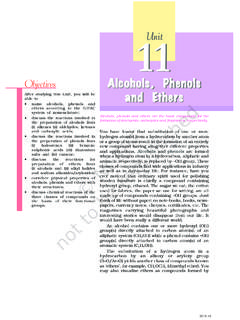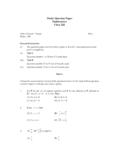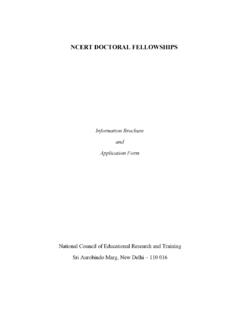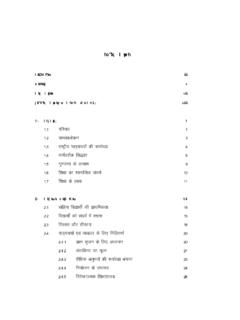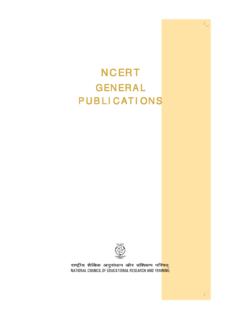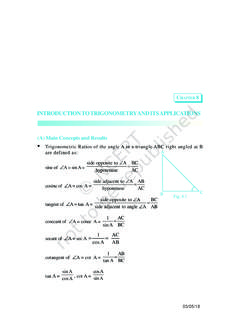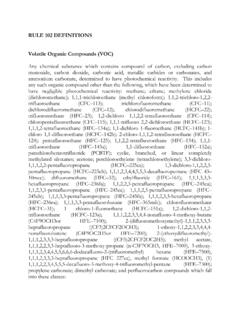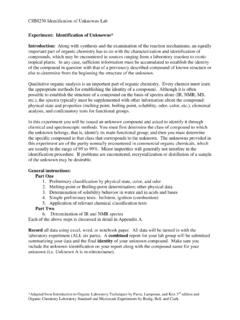Transcription of Unit - 9 - NCERT
1 In the previous Unit we learnt that the transition metalsform a large number of complex compounds in whichthe metal atoms are bound to a number of anions orneutral molecules. In modern terminology suchcompounds are called coordination compounds. Thechemistry of coordination compounds is an importantand challenging area of modern inorganic concepts of chemical bonding and molecularstructure have provided insights into the functioning ofvital components of biological systems. Chlorophyll,haemoglobin and vitamin B12 are coordinationcompounds of magnesium, iron and cobalt of metallurgical processes, industrial catalystsand analytical reagents involve the use of coordinationcompounds. coordination compounds also find manyapplications in electroplating, textile dyeing andmedicinal studying this Unit, you will beable to appreciate the postulates ofWerner s theory of coordinationcompounds; know the meaning of the terms: coordination entity, central atom/ion, ligand, coordination number, coordination sphere, coordinationpolyhedron, oxidation number,homoleptic and heteroleptic; learn the rules of nomenclatureof coordination compounds; write the formulas and namesof mononuclear coordinationcompounds; define different types of isomerismin coordination compounds; understand the nature of bondingin coordination compounds interms of the Valence Bond andCrystal Field theories; learn the stability of coordinationcompounds.
2 Appreciate the importance andapplications of coordinationcompounds in our day to day Compounds are the backbone of modern inorganic andbio inorganic chemistry and chemical Werner (1866-1919), a Swiss chemist was the first to formulatehis ideas about the structures of coordination compounds. He preparedand characterised a large number of coordination compounds andstudied their physical and chemical behaviour by simple experimentaltechniques. Werner proposed the concept of a primary valence and asecondary valence for a metal ion. Binary compounds such as CrCl3,CoCl2 or PdCl2 have primary valence of 3, 2 and 2 respectively. In aseries of compounds of cobalt(III) chloride with ammonia, it was foundthat some of the chloride ions could be precipitated as AgCl on addingexcess silver nitrate solution in cold but some remained in Werner Werner Werner Werner sssssTheory ofTheory ofTheory ofTheory ofTheory ofCoordinationCoordinationCoordinationCo ordinationCoordinationCompoundsCompounds CompoundsCompoundsCompounds9 UnitUnitUnitUnitUnit92015-16(20/01/2015) 238 Chemistry1 (Yellow) gave3 mol AgCl1 (Purple) gave2 mol AgCl1 (Green) gave1 mol AgCl1 (Violet) gave1 mol AgClThese observations, together with the results of conductivitymeasurements in solution can be explained if (i) six groups in all,either chloride ions or ammonia molecules or both, remain bonded tothe cobalt ion during the reaction and (ii)
3 The compounds are formulatedas shown in Table , where the atoms within the square bracketsform a single entity which does not dissociate under the reactionconditions. Werner proposed the term secondary valence for thenumber of groups bound directly to the metal ion; in each of theseexamples the secondary valences are that the last two compounds in Table have identical empiricalformula, , but distinct properties. Such compounds aretermed as isomers. Werner in 1898, propounded his theory ofcoordination compounds. The main postulates coordination compounds metals show two types of linkages(valences)-primary and primary valences are normally ionisable and are satisfied bynegative secondary valences are non ionisable. These are satisfied byneutral molecules or negative ions. The secondary valence is equal tothe coordination number and is fixed for a ions/groups bound by the secondary linkages to the metal havecharacteristic spatial arrangements corresponding to differentcoordination modern formulations, such spatial arrangements are calledcoordination polyhedra.
4 The species within the square bracket arecoordination entities or complexes and the ions outside the squarebracket are called counter further postulated that octahedral, tetrahedral and square planargeometrical shapes are more common in coordination compounds oftransition metals. Thus, [Co(NH3)6]3+, [CoCl(NH3)5]2+ and [CoCl2(NH3)4]+are octahedral entities, while [Ni(CO)4] and [PtCl4]2 are tetrahedral andsquare planar, conductivitycorresponds toTable : Formulation of Cobalt(III) Chloride-Ammonia ComplexesYellow[Co(NH3)6]3+3Cl 1:3 electrolytePurple[CoCl(NH3)5]2+2Cl 1:2 electrolyteGreen[CoCl2(NH3)4]+Cl 1:1 electrolyteViolet[CoCl2(NH3)4]+Cl 1:1 electrolyte2015-16(20/01/2015)239 coordination Compounds(i) Secondary 4(ii) Secondary 6(iii) Secondary 6(iv) Secondary 6(v) Secondary 4On the basis of the following observations made with aqueous solutions,assign secondary valences to metals in the following compounds:SolutionSolutionSolutionSoluti onSolutionDifference between a double salt and a complexBoth double salts as well as complexes are formed by the combinationof two or more stable compounds in stoichiometric ratio.
5 However, theydiffer in the fact that double salts such as carnallite, ,Mohr s salt, FeSO4.(NH4) , potash alum, KAl(SO4) , into simple ions completely when dissolved in water. However,complex ions such as [Fe(CN)6]4 of K4[Fe(CN)6] do not dissociate intoFe2+ and CN was born on December 12, 1866, in M lhouse,a small community in the French province of study of chemistry began in Karlsruhe (Germany)and continued in Zurich (Switzerland), where in hisdoctoral thesis in 1890, he explained the difference inproperties of certain nitrogen containing organicsubstances on the basis of isomerism. He extended vantHoff s theory of tetrahedral carbon atom and modifiedit for nitrogen. Werner showed optical and electrical differences betweencomplex compounds based on physical measurements. In fact, Werner wasthe first to discover optical activity in certain coordination , at the age of 29 years became a full professor at TechnischeHochschule in Zurich in 1895.
6 Alfred Werner was a chemist and accomplishments included the development of the theory of coordinationcompounds. This theory, in which Werner proposed revolutionary ideas abouthow atoms and molecules are linked together, was formulated in a span ofonly three years, from 1890 to 1893. The remainder of his career was spentgathering the experimental support required to validate his new ideas. Wernerbecame the first Swiss chemist to win the Nobel Prize in 1913 for his workon the linkage of atoms and the coordination theory.(1866-1919)(1866-1919)(1866-1919) (1866-1919)(1866-1919)FormulaMoles of AgCl precipitated per mole ofthe compounds with excess AgNO3(i) (ii) (iii) (iv) (v) (20/01/2015)240 Chemistry(a) coordination entityA coordination entity constitutes a central metal atom or ion bondedto a fixed number of ions or molecules. For example, [CoCl3(NH3)3]is a coordination entity in which the cobalt ion is surrounded bythree ammonia molecules and three chloride ions.
7 Other examplesare [Ni(CO)4], [PtCl2(NH3)2], [Fe(CN)6]4 , [Co(NH3)6]3+.(b)Central atom/ionIn a coordination entity, the atom/ion to which a fixed numberof ions/groups are bound in a definite geometrical arrangementaround it, is called the central atom or ion. For example, thecentral atom/ion in the coordination entities: [NiCl2(H2O)4],[CoCl(NH3)5]2+ and [Fe(CN)6]3 are Ni2+, Co3+ and Fe3+, central atoms/ions are also referred to as Lewis acids.(c)LigandsThe ions or molecules bound to the central atom/ion in thecoordination entity are called ligands. These may be simple ionssuch as Cl , small molecules such as H2O or NH3, larger moleculessuch as H2 NCH2CH2NH2 or N(CH2CH2NH2)3 or even macromolecules,such as a ligand is bound to a metal ion through a single donoratom, as with Cl , H2O or NH3, the ligand is said to be a ligand can bind through two donor atoms as inH2 NCH2CH2NH2 (ethane-1,2-diamine) or C2O42 (oxalate), theligand is said to be didentate and when several donor atoms arepresent in a single ligand as in N(CH2CH2NH2)3, the ligand is saidto be polydentate.
8 Ethylenediaminetetraacetate ion (EDTA4 ) isan important hexadentate ligand. It can bind through twonitrogen and four oxygen atoms to a central metal a di- or polydentate ligand uses its two or more donoratoms to bind a single metal ion, it is said to be a chelate number of such ligating groups is called the denticity of theligand. Such complexes, called chelate complexes tend to be morestable than similar complexes containing unidentate ligands (forreasons see Section ). Ligand which canligate through two different atoms is calledambidentate ligand. Examples of suchligands are the NO2 and SCN ions. NO2 ioncan coordinate either through nitrogen orthrough oxygen to a central metal , SCN ion can coordinate through thesulphur or nitrogen atom.(d) coordination numberThe coordination number (CN) of a metal ion in a complex can bedefined as the number of ligand donor atoms to which the metal isdirectly bonded.
9 For example, in the complex ions, [PtCl6]2 and[Ni(NH3)4]2+, the coordination number of Pt and Ni are 6 and 4respectively. Similarly, in the complex ions, [Fe(C2O4)3]3 and[Co(en)3]3+, the coordination number of both, Fe and Co, is 6 becauseC2O42 and en (ethane-1,2-diamine) are didentate ofDefinitions ofDefinitions ofDefinitions ofDefinitions ofSomeSomeSomeSomeSomeImportantImportant ImportantImportantImportantTermsTermsTer msTermsTermsPertaining toPertaining toPertaining toPertaining toPertaining toCoordinationCoordinationCoordinationCo ordinationCoordinationCompoundsCompounds CompoundsCompoundsCompounds2015-16(20/01 /2015)241 coordination CompoundsIt is important to note here that coordination number of the centralatom/ion is determined only by the number of sigma bonds formed bythe ligand with the central atom/ion. Pi bonds, if formed between theligand and the central atom/ion, are not counted for this purpose.
10 (e) coordination sphereThe central atom/ion and the ligands attached to it are enclosed insquare bracket and is collectively termed as the coordinationsphere. The ionisable groups are written outside the bracket andare called counter ions. For example, in the complex K4[Fe(CN)6],the coordination sphere is [Fe(CN)6]4 and the counter ion is K+.(f) coordination polyhedronThe spatial arrangement of the ligand atoms which are directlyattached to the central atom/ion defines a coordinationpolyhedron about the central atom. The most commoncoordination polyhedra are octahedral, square planar andtetrahedral. For example, [Co(NH3)6]3+ is octahedral, [Ni(CO)4] istetrahedral and [PtCl4]2 is square planar. Fig. shows theshapes of different coordination (g)Oxidation number of central atomThe oxidation number of the central atom in a complex is definedas the charge it would carry if all the ligands are removed alongwith the electron pairs that are shared with the central atom.
